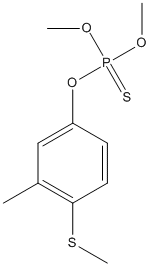Fenthion
In Australia and the USA, fenthion is used for agricultural purposes and to control cockroaches, crickets, flies, mosquitoes and spiders. It is also present in veterinary drug formulations to control fleas on dogs in Australia, and used as a mosquito adulticide, to control lice, flies, and ticks on cattle and swine or dragonfly larvae in aquaculture Like other organophosphotohionate pesticides fenthion is not active on AChE per se, but it has to be bioactivated: sulfoxidation to fenthion-sulfoxide (FEN-sulfoxide), catalyzed by cytochrome P450 or flavin-containing monooxygenase, and a CYP-mediated oxidative desulfuration to form fenthion-oxon
General
Type : Insecticide,Organophosphate,Sulfur Compound,Organothiophosphate
Chemical_Nomenclature : dimethoxy-(3-methyl-4-methylsulfanylphenoxy)-sulfanylidene-$l^{5}-phosphane
Canonical SMILES : CC1=C(C=CC(=C1)OP(=S)(OC)OC)SC
InChI : InChI=1S\/C10H15O3PS2\/c1-8-7-9(5-6-10(8)16-4)13-14(15,11-2)12-3\/h5-7H,1-4H3
InChIKey : PNVJTZOFSHSLTO-UHFFFAOYSA-N
Other name(s) : O,O-dimethyl-O-[4-(methylthio)-m-tolyl] phosphorothioate,phorothioic acid O,O-dimethyl O-[3-methyl-4-(methylthio)phenyl]ester,dimethyl 3-methyl-4-methylthiophenyl phosphorothionate,Fention,Baycid,Queletox,Spotten,Talodex,Tiguvon,Mercaptophos,Baytex,Entex,Lebaycid,Fenthione,Phenthion,Spotton,Sulfidophos,Figuron,Fenthion-methyl,Bayer 29493,Fenthion 4E,MPP (pesticide),Bayer 9007,Bayer S-1752,OMS 2,UNII-BL0L45OVKT,NCI-C08651,BAY 29493,ENT 25,540,CHEBI:34761,SCHEMBL26907,ZINC1443,CHEMBL1604375
MW : 278.33
Formula : C10H15O3PS2
CAS_number : 55-38-9
PubChem : 3346
UniChem : PNVJTZOFSHSLTO-UHFFFAOYSA-N
IUPHAR :
Wikipedia : Fenthion

Target
References (10)
| Title : Chronic fenthion toxicity in laying hens - Tuler_1999_Vet.Hum.Toxicol_41_302 |
| Author(s) : Tuler SM , Bowen JM |
| Ref : Vet Hum Toxicol , 41 :302 , 1999 |
| Abstract : Tuler_1999_Vet.Hum.Toxicol_41_302 |
| ESTHER : Tuler_1999_Vet.Hum.Toxicol_41_302 |
| PubMedSearch : Tuler_1999_Vet.Hum.Toxicol_41_302 |
| PubMedID: 10509433 |
| Title : The relationship between maternal and fetal effects following maternal organophosphate exposure during gestation in the rat - Astroff_1998_Toxicol.Ind.Health_14_869 |
| Author(s) : Astroff AB , Young AD |
| Ref : Toxicol Ind Health , 14 :869 , 1998 |
| Abstract : Astroff_1998_Toxicol.Ind.Health_14_869 |
| ESTHER : Astroff_1998_Toxicol.Ind.Health_14_869 |
| PubMedSearch : Astroff_1998_Toxicol.Ind.Health_14_869 |
| PubMedID: 9891917 |
| Title : Effect of combined fenthion and cimetidine use in rats on lethality, blood cholinesterase activities, and serum cholinesterase isoenzymes - Sakaguchi_1998_Vet.Hum.Toxicol_40_77 |
| Author(s) : Sakaguchi K , Akahori F , Shirai M , Masaoka T , Arishima K , Kounenis G |
| Ref : Vet Hum Toxicol , 40 :77 , 1998 |
| Abstract : Sakaguchi_1998_Vet.Hum.Toxicol_40_77 |
| ESTHER : Sakaguchi_1998_Vet.Hum.Toxicol_40_77 |
| PubMedSearch : Sakaguchi_1998_Vet.Hum.Toxicol_40_77 |
| PubMedID: 9554058 |
| Title : Organophosphate resistance in Culex pipiens from Cyprus - Wirth_1996_J.Am.Mosq.Control.Assoc_12_112 |
| Author(s) : Wirth MC , Georghiou GP |
| Ref : J Am Mosq Control Assoc , 12 :112 , 1996 |
| Abstract : Wirth_1996_J.Am.Mosq.Control.Assoc_12_112 |
| ESTHER : Wirth_1996_J.Am.Mosq.Control.Assoc_12_112 |
| PubMedSearch : Wirth_1996_J.Am.Mosq.Control.Assoc_12_112 |
| PubMedID: 8723267 |
| Title : Insecticide susceptibility in mosquitoes (Diptera: Culicidae) from French Polynesia - Failloux_1994_J.Med.Entomol_31_639 |
| Author(s) : Failloux AB , Ung A , Raymond M , Pasteur N |
| Ref : Journal of Medical Entomology , 31 :639 , 1994 |
| Abstract : Failloux_1994_J.Med.Entomol_31_639 |
| ESTHER : Failloux_1994_J.Med.Entomol_31_639 |
| PubMedSearch : Failloux_1994_J.Med.Entomol_31_639 |
| PubMedID: 7966164 |
| Title : Sister-chromatid exchanges and cell-cycle delay in Chinese hamster V79 cells treated with 9 organophosphorus compounds (8 pesticides and 1 defoliant) - Chen_1982_Mutat.Res_103_307 |
| Author(s) : Chen HH , Sirianni SR , Huang CC |
| Ref : Mutat Res , 103 :307 , 1982 |
| Abstract : Chen_1982_Mutat.Res_103_307 |
| ESTHER : Chen_1982_Mutat.Res_103_307 |
| PubMedSearch : Chen_1982_Mutat.Res_103_307 |
| PubMedID: 6211614 |
| Title : Recovery of brain and plasma cholinesterase activities in ducklings exposed to organophosphorus pesticides - Fleming_1981_Arch.Environ.Contam.Toxicol_10_215 |
| Author(s) : Fleming WJ |
| Ref : Archives of Environmental Contamination & Toxicology , 10 :215 , 1981 |
| Abstract : Fleming_1981_Arch.Environ.Contam.Toxicol_10_215 |
| ESTHER : Fleming_1981_Arch.Environ.Contam.Toxicol_10_215 |
| PubMedSearch : Fleming_1981_Arch.Environ.Contam.Toxicol_10_215 |
| PubMedID: 7224673 |
| Title : Laval implant sutdies with Lucilia cuprina - Shanahan_1978_Vet.Rec_103_582 |
| Author(s) : Shanahan GJ , Hughes PB |
| Ref : Vet Rec , 103 :582 , 1978 |
| Abstract : Shanahan_1978_Vet.Rec_103_582 |
| ESTHER : Shanahan_1978_Vet.Rec_103_582 |
| PubMedSearch : Shanahan_1978_Vet.Rec_103_582 |
| PubMedID: 318562 |
| Title : Problems of housefly (Musca domestica) control due to multiresistance to insesticides - Keiding_1975_J.Hyg.Epidemiol.Microbiol.Immunol_19_340 |
| Author(s) : Keiding J |
| Ref : J Hyg Epidemiol Microbiol Immunol , 19 :340 , 1975 |
| Abstract : Keiding_1975_J.Hyg.Epidemiol.Microbiol.Immunol_19_340 |
| ESTHER : Keiding_1975_J.Hyg.Epidemiol.Microbiol.Immunol_19_340 |
| PubMedSearch : Keiding_1975_J.Hyg.Epidemiol.Microbiol.Immunol_19_340 |
| PubMedID: 52667 |
| Title : Zur Kenntnis neuer, wenig toxischer lnsektizide auf der Basis von Phosphorsaureestern - Schrader_1961_Angew.Chem_73_331 |
| Author(s) : Schrader G |
| Ref : Angewandte Chemie , 73 :331 , 1961 |
| Abstract : Schrader_1961_Angew.Chem_73_331 |
| ESTHER : Schrader_1961_Angew.Chem_73_331 |
| PubMedSearch : Schrader_1961_Angew.Chem_73_331 |
| PubMedID: |